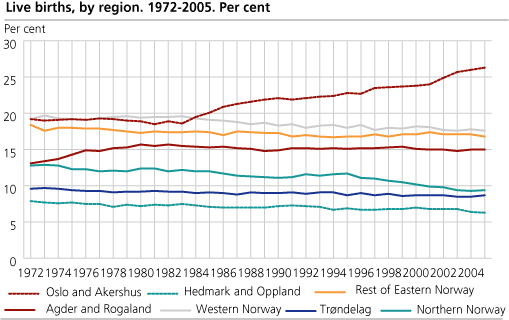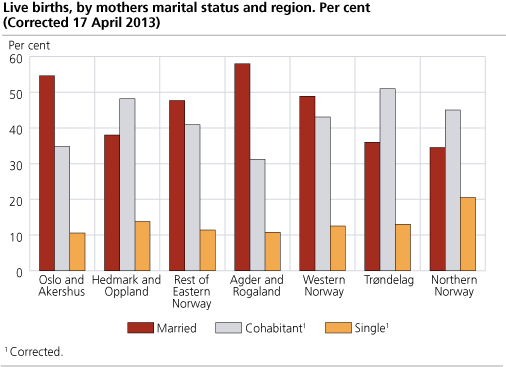Content
Published:
This is an archived release.
Centralization of births
More and more children are born in the central eastern Norway. Last year 26.3 per cent of all newborns were born in Oslo and Akershus, which is an increase of more than 40 per cent during the last 20 years.
In 2005 56 756 children were born in Norway, and the total fertility rate (TFR) was 1.84 children per woman. Almost 15 000 of the children were born in Oslo and Akershus. The centralization of births is mainly due to the continuous in-migration to the Oslo-area, over a long period of time, which has lead to an accumulation of women in their fertile ages in the central parts of the country.
At the same time there is a decrease in births in the least central parts of Norway. This is particular evident in the region Northern Norway, but also in Western Norway and Hedmark and Oppland.
More equal fertility level between the counties
Differences in fertility between the counties are decreasing. In the beginning of the 1970s TFR in Oslo were 1.67 children and the corresponding figure for Finnmark was 2.73. In 2005 the TFR for women residing in Oslo was 1.78 and for women residing in Finnmark 1.87.
For Oslo this is the highest fertility level since the 1960s. Highest fertility in Norway was found in Sogn and Fjordane and in Rogaland, with a total fertility rate at 2.07 and 2.01 respectively.
On average the parents' age at birth was 30.2 years for women and 33.3 years for men in 2005, the same level as in 2004. When looking at age-specific fertility rates for women there is a constant decrease in births for the youngest women, while it gets more common to give birth at higher age. Highest fertility rates were found among women aged 25-29 years, but the gap to women aged 30-34 years decreases continually.
Most cohabitating mothers in Trøndelag
There are considerable differences in the mother’s marital status between regions. Trøndelag has the highest proportion of cohabitating mothers, where 51 per cent 1 are cohabitants. Agder and Rogaland have the lowest proportion of cohabitating mothers.
1 The number has been corrected, 17.04.2013.
Tables:
- Table 1 Live births and late foetal deaths. 1951-2005
- Table 2 Confinements of single and multiple births, by sex. 1991-2005 (Updated 26 June 2006)
- Table 3 Age-specific fertility rates and total fertility rate. 1961-2005
- Table 4 Average age at birth. 1946-2005
- Table 5 Total fertility rate, by county. 1968-2005 (Updated 26 June 2006)
- Table 6 Live births, by parity. 1978-2005
- Table 7 Live births, by parity, cohabitation status of mother and county. 2005
- Table 8 Number of children distributed, by age and cohort . Per cent
Contact
-
Statistics Norway's Information Centre
E-mail: informasjon@ssb.no
tel.: (+47) 21 09 46 42
-
Espen Andersen
E-mail: espen.andersen@ssb.no
tel.: (+47) 92 61 00 46
-
Ane Margrete Tømmerås
E-mail: ane.tommeras@ssb.no
tel.: (+47) 91 99 29 62
-
Oppdrag befolkningsstatistikk
E-mail: befolkning@ssb.no


